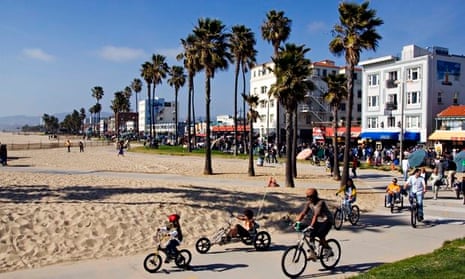Los Angeles is one of the world's most car-centric cities, and when self-professed fearless cyclist Nona Varnado moved there from New York, she faced very real anxiety when trying to share the road with drivers who, she says, would kill you to save two seconds.
However, after overcoming her own fears, Varnado founded LA Bike Trains – free, weekly rides led by proficient cyclists across the city giving would-be bike commuters the routes, the skills and the confidence to ride to work.
So, what it's really like cycling in LA? Varnado says:
That would depend who you ask. I've lived without a car all over the world and I'm definitely in the category of what most people would call fearless.
When I first moved to Los Angeles I almost bought a car because I was so scared. I've been a bike messenger, and when I was younger I did fixed gear alleycat races, really crazy stuff, and so that was why I felt I could go anywhere and ride a bike, no problem.
However, Varnado says, LA was a different experience altogether.
I was experiencing anxiety, I stopped leaving the house. I realised I wasn't doing things because in my mind everything seemed so spread out and the sprawl is so great, and the traffic is of a different nature.
There's no regularity between how a lane is between one block to another and drivers are going from 30 to 50 miles an hour to get on the freeway. Trying to get anywhere you're going to have to go past freeway on-ramps and you're also dealing with cars that don't expect a cyclist.
To me what is the most scary thing about Southern California is that drivers have this entitlement mentality. That means people don't care if they kill you. It is as simple as that.
They're trying to save two seconds, and if you need to die to save them two seconds they will kill you.
Things turned around for her when, working in an LA bike shop, colleagues showed her how to handle the traffic, and find the "secret" routes away from the main roads.
From designing women's cycle clothes, and talking to women buying those clothes, Varnado saw what she describes as a "huge humanitarian need for activism", the empowering potential of the bike, financial and otherwise. She also recognised the need for positive one-to-one experiences, like hers at the bike shop, to get people cycling. With protected cycle lanes LA would be a bike paradise, she says, but since she couldn't build the infrastructure herself, the way to change was a social solution.

Varnado studied other bike trains – where they worked and where they fell down, treating it like a business model. Through local campaigners such as the Los Angeles County Bicycle Coalition and Bike Week she found support and a pool of passionate volunteers.
Those volunteers were all very vocal. We just started getting people to try it, and they would talk about it with their co-workers and we got picked up on a lot of local transportation blogs. Once it got out that there was some crazy group of friendly cyclists helping people to navigate the city for free, with an emphasis on safety, it became a novelty and so all these media outlets were asking: how is this possible?
She believes part of its success is accessibility and fun.
There's no obligation, there's no pressure, it's free, it's not scary, we're the nicest, most cuddly introduction to biking in LA that you could get. We don't charge and we're on schedule every week.
That reliability, she says, is crucial, as it is with any form of transport.
There are now 10 routes, with an online survey to test demand for more. According to Varnado about a third of her bike train commuters are what she calls graduates, people who build up their confidence and skills over two or three weeks and then leave, hopefully to become independent commuters. The rest, she says, are a diverse array of regulars.
This is the big success of LA Bike Trains: We get every shape, age, colour, income. We've developed a very flexible model that can go into any community in LA.
In younger communities, such as Silver Lake, the bike train is organised online. The south LA train, meanwhile, is run "almost entirely out of a park". Some conductors (ride leaders) even put hotel-style door hangers on bikes, that look like love letters, to encourage new riders. There are natural fluctuations in numbers, with anything from two commuters upwards in each train. It's intensive but clearly worth it for Varnado and her team.
What kind of people get involved?
Our conductors are the nicest, most wonderful people on the planet and they really do care about other people and about their city. They say: "I want it to be safe for my children to ride. I had to be a daredevil but I don't want my daughter to have to be."
Have there been any particular success stories?
There's so many, it's like picking bonbons from a jar. One of my favourites is Barbara. She hadn't biked in many years, she was really out of shape, she didn't think she could do it, she needed an incredible amount of help and now she's a committed regular. Not only has her health improved, now she bikes her daughter to school, so that's impacted positively on both of their lives.

Comments (…)
Sign in or create your Guardian account to join the discussion